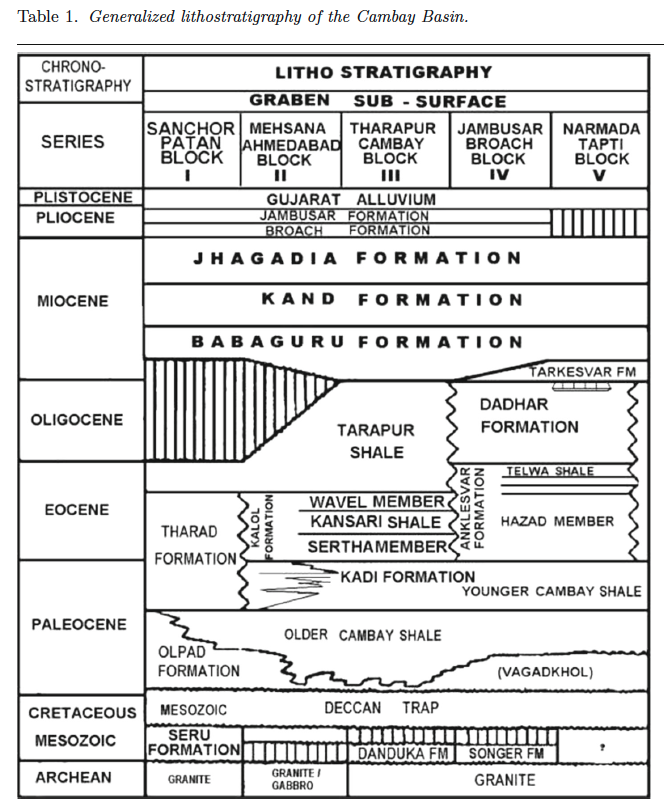Olpad Fm
Type Locality and Naming
SUBSURFACE: Olpad Well -1A (depth interval 1468 m to 2443 m). [Original Publication: Chandra, P.K. and Chowdhary, L.R. (1969) Stratigraphy of the Cambay Basin, ONGC Bulletin, Vol 6 (2), pp: 202-203.]
Synonyms: Initially the formation as represented by volcanic trap wash or trap wacke, was recognized in eastern margin outcrops near Vagadkhol village (Sudhakar and Roy, 1959), though no type section was defined. Rao (1969) and Chandra and Chowdhary (1969) have referred to this formation as the Olpad Formation with the designated type section in Olpad well-1A. Later workers have followed the same nomenclature. However, Sudhakar and Basu (1973) proposed a new name 'Vagadkhol Formation' for this unit. Roy-Choudhary et al. (1972) proposed the name 'Balutri Formation' for the conglomerate sequence overlying the Deccan Traps Fm with Serau East-1 as type section. The name 'Olpad Formation' has been preferred by Pandey et al., (1993) due to its priority in subsurface and popularity in usage.
Lithology and Thickness
Volcaniclastics. In the type section, it comprises of volcanic conglomerate, sandstone, silt, shale, claystone, and clays exclusively derived from basalts.
Sudhakar and Basu (1973) have divided the Olpad into two lithosomes with varying degrees of intermixture: Grey and mottled claystone lithosome and trap conglomerate-sandstone lithosome. Pandey et al., (1993) have divided the Olpad Formation into three lithosomes; the upper sandstone lithosome, middle claystone lithosome, and the lower trap lithosome. In one exploratory well, the Olpad Formation is subdivided into three members: (i) Trapwash Member, (ii) Claystone Member, and (iii) Nawagam Member.
Maximum thickness is 1778 m in Jambusar P-I
[Figure 2: Generalized stratigraphy of the Cambay Basin. (from Jaiswal and Bhattacharya, 2018, J.EarthSyst.Sci., 127:65)]
Relationships and Distribution
Lower contact
The formation unconformably overlies the Deccan Traps Fm.
Upper contact
It has gradational and intertonguing relationship with overlying younger Cambay Fm shale.
Regional extent
The formation is mostly developed in subsurface Cambay Basin.
GeoJSON
Fossils
Poorly fossiliferous and the fauna (after Pandey et al., 1993) recorded are thin-walled fresh water gastropods, bivalves shells and chitinous plates. Palynoflora recorded from this formation includes Proxapertites microreticulatus, Dicolpopollis sp; Proxapertites assamicus Monocolpopollanites sp; Polypodisporites sp; Laevigatosporites sp; and Cyathidites sp.
Age
Depositional setting
Additional Information
